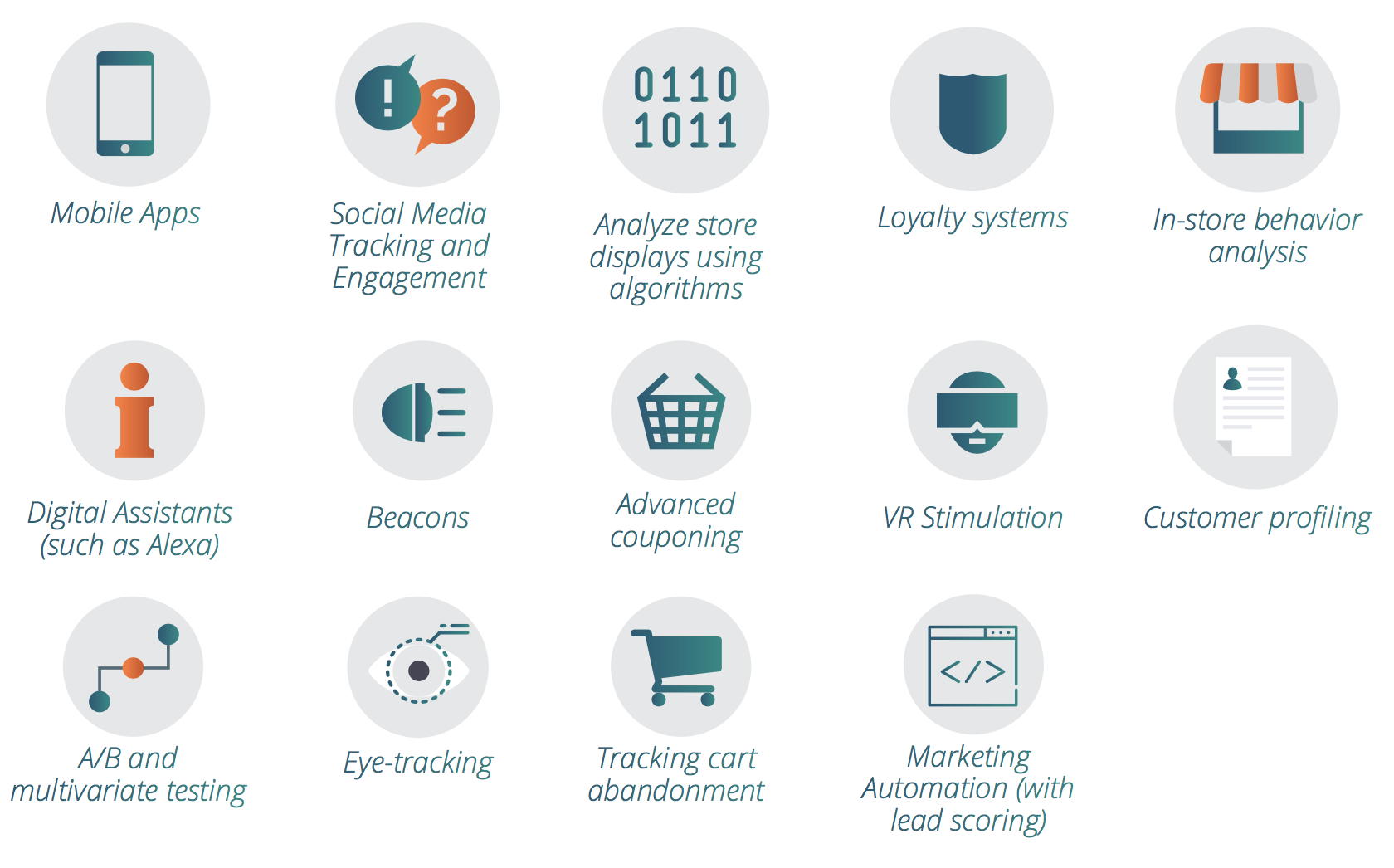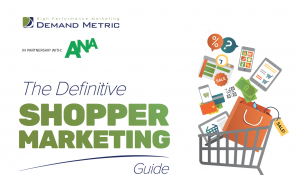What is Shopper Marketing?
For consumers, we view our shopping experiences as a straightforward process. We need (or want) something, and we go get it, through whatever channel is most convenient for us. Whether it’s online or bricks-and-mortar retail, we see our buying journey as a relatively simple one, and one over which we are in complete control. The reality is actually quite a bit different. As consumers, many information sources consciously and subconsciously influence our shopping journey. Savvy retailers understand this, and this understanding is creating a competitive advantage for them in the form of shopper marketing.
Wikipedia defines shopper marketing this way: “understanding how one's target consumers behave as shoppers, in different channels and formats, and leveraging this intelligence to the benefit of all stakeholders, defined as brands, consumers, retailers and shoppers.” Let’s explore how we entered this relatively new era of shopper marketing. Demand Metric has created The Definitive Shopper Marketing Guide to help retailers, brands and B-to-C organizations understand what shopper marketing is, and how to take advantage of it.
The Golden Age of Advertising
Attitudes have changed today. Overexposure to advertising has numbed many consumers to the messages and influences of advertising. In fact, we employ pop-up ad blockers in our browsers, and the fast-forward feature of our DVRs to skip past ads, while readily paying fees to streaming services to avoid exposure to advertising. Most of us simply got tired of all the noise. In this climate that is increasingly dismissive of advertising, the shopper marketing strategy has emerged.
Today, brands and retailers are working together to use the data they’ve amassed to derive insights about how consumers are influenced and how they shop. These insights allow the creation of targeted marketing strategies that let brands and retailers compete more effectively and get better results. This is what shopper marketing is all about, and much of it is happening online.
The Shopper Marketing Ecosystem
- Brands: have the most at stake in getting their product or service to market. Their goal is to build awareness around their offerings, promoting them to increase sales and to ensure continuous consumption. Brands seek to build strong relationships with retailers.
- Retailers / E-tailers: sell brand products to the shoppers and see shopper marketing as a tool to drive sales. Their main goal is to grow the success of product categories at their stores, and build loyalty from the shoppers.
- Agencies: represent retailers and brands, helping them craft insightful campaigns that build engagement with shoppers seeking solutions. Agencies bring shopper marketing to life for their clients.
- Shoppers: the individuals who visit retailers, choose brands, and make purchases. Their shopping habits range from highly structured to spontaneous, but both seek to address wants and needs.
In this ecosystem, consumers and shoppers are not the same. Consuming is easy and often gratifying, but is doesn’t drive brand awareness or build brand equity. While consumption drives shopping, shoppers have a different focus than consumers. Shopper behavior is focused on solving problems, and they seek products or services that they, or others, will eventually consume. Shoppers are the ones making purchase decisions.
Marketers can easily get confused about this distinction. A well-known brand of beer found this out as they used images of beautiful women to promote their product, but the data about shopping versus consuming revealed that a vast majority of the time, women were shopping for and purchasing the beer that men consumed. Insights like this one come from implementing a shopper marketing strategy.
Shopper Marketing is Data-Centric
The traditional view of shopper marketing is a linear “path-to-purchase” one, but data reveals that shoppers routinely move between buying stages in non-linear fashion, going back and forth as they make their purchase decisions. This is why data is so important to a shopper marketing strategy, because without it, an accurate picture of the shopping journey remains shrouded.
Shopper marketing data spans shopper reactions to products in online or physical stores, to layouts of stores or webpages. More than ever, the shopper marketing experience is omni-channel, so collaboration between brands, retailers and agencies is required to collect and integrate the data to assemble a holistic view of the shopping journey. Effective data management is at the core of successful Shopper Marketing. Demand Metric has created a Shopper Marketing Metrics Dashboard to help marketers identify and track the data that helps drive their shopper marketing initiatives.
Executing a Shopper Marketing Strategy
- First, know Your shoppers. Different shoppers can have very different shopping journeys. Start by understanding how each type of shopper moves through their shopping journey and identify what their priorities are as they shop. The Demand Metric Shopper Marketing Journey Stages template will help you do this.
- Identify the desired shopper behavior(s). After you understand your shoppers, identify the behaviors that, when present, are most favorable to the outcomes you’re trying to achieve. How must you change shopper purchase behavior to produce those outcomes?
- Determine the channels in which you will create the desired behavior(s). In which channel, if you could influence shopper behavior, would have the greatest impact? In which channel is it easiest to influence behavior? Each channel provides a different opportunity.
- Create a marketing mix that influences behavior of target shoppers in the selected channels. What changes to the traditional marketing mix – Product, Place, Price and Promotion – will drive the ideal shopper behaviors? The scope of your efforts should include digital and traditional retail, as well as how you will incent retailers to get their participation.
Before embarking on a shopper marketing initiative, it’s wise to understand your organization’s level of maturity. The chart below was developed by Arc Worldwide/Leo Burnett as a means to assess client maturity.

Regardless of where you are on this spectrum, your goal is to gain success and move to the right. Success on the shopper marketing journey requires the discipline and commitment to have an understanding based on data of where the shopper is so that you can confidently plan the future steps in your shopper marketing strategy. Use the Demand Metric Shopper Marketing Maturity Assessment to find out where you are on this spectrum.
Shopper Marketing Challenges
Designing and executing a successful shopper marketing program comes with issues and challenges. Recent research by the Association of National Advertisers (ANA) that was published in “Shopper Marketing: The Next Generation” identifies these key challenges to implementing a shopper marketing strategy:
- Taking an omnichannel approach to reach end users at all touchpoints
- Having bricks-and-mortar visits mirror the effectiveness of the online environment
- Using social media to drive traffic to retailers and develop online communities afterward
- Exploiting mobile in shopper marketing campaigns, by engaging consumers pre-store, in-store, and post visit
These challenges have different origins. Sometimes, organizational “silos” are the cause, making the collaboration between the brand, retailer and agencies difficult. Other times a lack of data, tools or the skills to use them hinders success. Overcoming these challenges requires a commitment of all the players to work together, communicating well, coordinating activities and working toward the same objectives while producing campaigns that are driven by insights.
Critical Success Factor: Digital & Social Acumen
Success with shopper marketing is very much enabled by data, technology and the skills to use them. Mobile apps, social media platforms, email coupons and virtual store simulations are but a few of the ways technology is an essential ingredient to shopper marketing. It’s important to have access to this technology and to know how to exploit it. Some of the key technologies for shopper marketing are summarized in this diagram:

These tools are the foundation of a shopper marketing initiative. When evaluating and choosing them, scalability, data integration, and price, are all factors to consider. None of these factors, however, is as important as the commitment to using them.
Summary
Each day brings news of yet another retailer on the verge of closing operations. With online retail giant Amazon pioneering drone-based and same-day delivery schemes, online shopping continues to threaten traditional bricks-and-mortar stores. In this environment, shopper marketing has emerged as not just a survival strategy, but a way to gain a competitive advantage. Through it, we can better understand the behaviors and preferences of shoppers, whether online or in a store. With that understanding, a brand or retailer can position itself as the preferred channel for shopper purchases.
In this guide, you will discover a distilled best practice approach to Shopper Marketing that will superpower your strategy and lead you in the direction of success.

